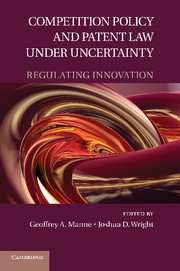Book contents
- Frontmatter
- Contents
- Contributors
- Introduction
- PART I THE INSTITUTIONS OF GROWTH
- PART II THE ECONOMICS OF INNOVATION
- PART III INNOVATION AND COMPETITION POLICY
- PART IV THE PATENT SYSTEM
- 9 Rewarding Innovation Efficiently
- 10 Presume Nothing
- 11 Patent Notice and Cumulative Innovation
- PART V PROPERTY RIGHTS AND THE THEORY OF PATENT LAW
- PART VI INTELLECTUAL PROPRETY AND ANTITRUST: THE REGULATION OF STANDARD-SETTING ORGANIZATIONS
- Index
- References
9 - Rewarding Innovation Efficiently
The Case for Exclusive Rights
Published online by Cambridge University Press: 05 June 2012
- Frontmatter
- Contents
- Contributors
- Introduction
- PART I THE INSTITUTIONS OF GROWTH
- PART II THE ECONOMICS OF INNOVATION
- PART III INNOVATION AND COMPETITION POLICY
- PART IV THE PATENT SYSTEM
- 9 Rewarding Innovation Efficiently
- 10 Presume Nothing
- 11 Patent Notice and Cumulative Innovation
- PART V PROPERTY RIGHTS AND THE THEORY OF PATENT LAW
- PART VI INTELLECTUAL PROPRETY AND ANTITRUST: THE REGULATION OF STANDARD-SETTING ORGANIZATIONS
- Index
- References
Summary
Introduction
The law provides various forms of legal protection for innovations, depending on the subject matter (manufactured items, artistic works, design, etc.) and degree of novelty. Patents are usually regarded as a strong form of protection, since they provide an exclusive right on the innovative technological knowledge. Copyrights and trade secrets, by contrast, are regarded as weak forms of protection, since they prohibit direct copying but not independent duplication.
The recent literature on the optimal breadth of IP rights has underscored the positive role of such independent duplicators in increasing the degree of product market competition, and hence in reducing the social costs of IP protection. This literature, while recognizing the risks of permitting outright copying of innovations, argues that parallel development and independent discovery should not be discouraged, since the benefits they induce on the competition side may outweigh their adverse effects on innovation. In this perspective, the optimal form of IP protection appears to be that provided by copyrights and trade secrecy, which do not prevent independent developers from practicing the innovation.
Building on the original insight of La Manna, Maurer and Scotchmer, Shapiro, Kultti and Takalo, and Henry, among others, have argued that patent protection should be weakened so as to allow second independent inventors to practice the innovations they obtain by parallel development. More specifically, they argue that independent inventors should be granted a defense to patent infringement (independent inventor defense).
- Type
- Chapter
- Information
- Competition Policy and Patent Law under UncertaintyRegulating Innovation, pp. 287 - 299Publisher: Cambridge University PressPrint publication year: 2011

